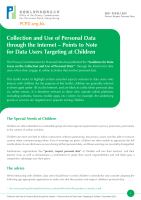

Collection and Use of Personal Data through the Internet – Points to Note for Data Users Targeting at Children / December 2015
Interaction with social networks
When data users require or allow children to use their social network accounts for interaction (such as logging in,
using “like”, “share” or similar action that may show the children’s social network account names) with their online
platforms, the children may not be aware that this interaction can be seen by other users of the social network or the
online platform. In many cases, the data users or others may be able to collate/combine information from the social
network and the online platforms to profile or identify the children. Data users should explain clearly to children
the implications of using social network accounts.
Best Practice Tip
• Data users should offer either anonymous log-in or allow children to create separate accounts (instead
of requiring or allowing the use of social network accounts) on their online platforms.
Redirection to other sites
As a best practice, when an online platform redirects children to another site, clear notice should be given to the
children. This is particularly important when the redirected site is not under the direct control of the same data user.
In the absence of such notice, children run the risk of unintentionally or unknowingly disclosing their own personal
data.
Best Practice Tip
• When redirecting children from one online platform to another, data users should display a message
telling the children details of the site they are being redirected to, and its relationship with the data users
(such as a subsidiary or related company, an organiser of events, etc.).
Direct marketing activities
The Ordinance prescribes circumstances where direct marketing using personal data are permissible. Data users
should be mindful that, even for non-profit making purposes, the promotion or advertising of services (including
solicitation of donation) is considered as direct marketing activities. They should familiarise themselves with the
requirements before conducting any direct marketing activities. Data users should, therefore, refer to the ‘New
Guidance on Direct Marketing’
3
issued by the Privacy Commissioner for Personal Data for details.
For example, data users who intend to use a child’s personal data in direct marketing, must inform the child
accordingly, obtain his prior consent
4
and provide him with a channel through which his consent may be
communicated.
Data users should note that even adults sometimes have problems navigating the various clauses and consent forms
of direct marketing, therefore expecting children to understand their rights in direct marketing may be unrealistic.
5
See
www.pcpd.org.hk/english/publications/files/GN_DM_e.pdf3
In the context of direct marketing, the meaning of the word “consent” includes an indication of no objection.
4
















